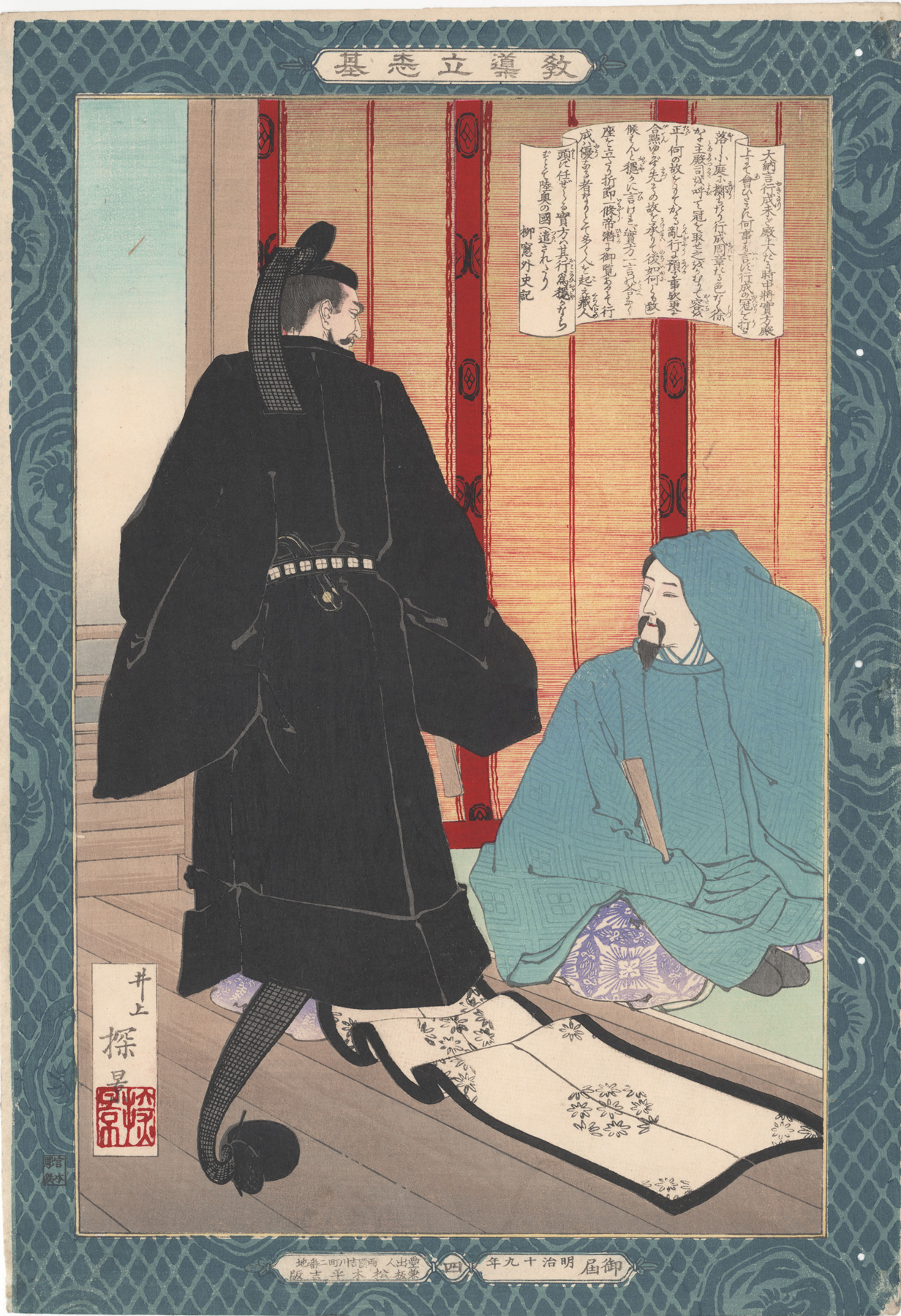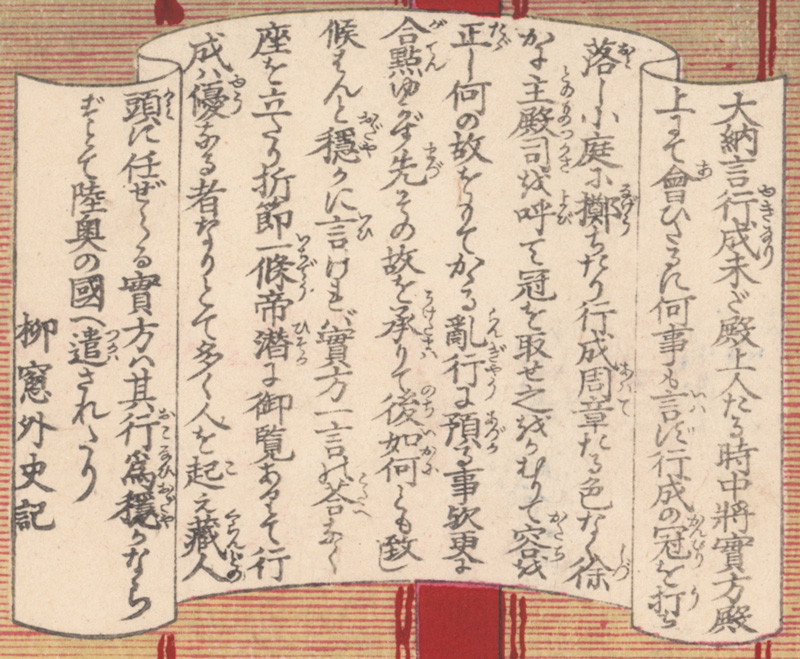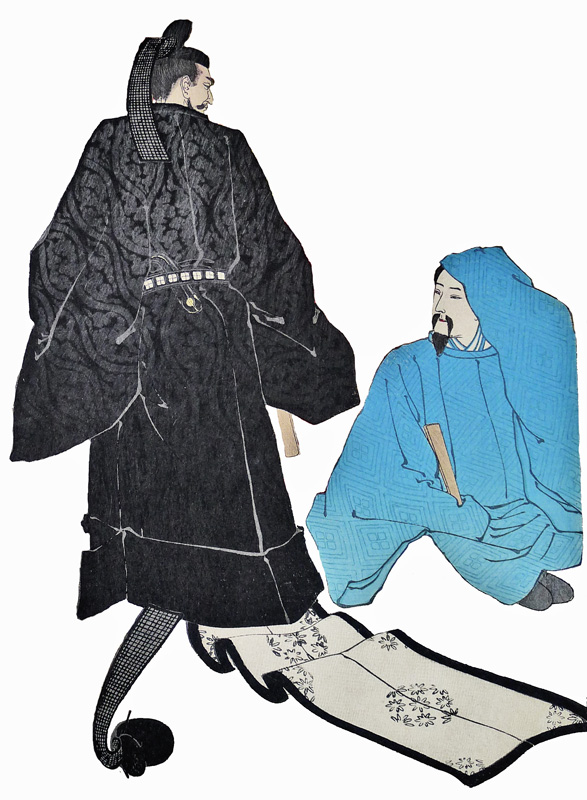About This Print
Print number 四 (4)1 in the series Instructive Models of Lofty Ambition picturing Fujiwara no Sanekata (藤原実方), in the black robe, glaring at the seated Dainagon2 Yukinari (大納言行成) whose kanmuri 冠 (lacquered hat) he has just knocked off. Yukinari, seated on the floor, wears a surprised look as his hand searches for his hat which now lies on the floor.While the print is known by the title Dainagon Yukinari, whose hat was knocked off, the incident is more associated with Fujiwara no Sanekata who was banished by the emperor to a northern province for this act.
Inoue, a student of Kobayashi Kiyochika, contributed thirteen prints to this series. He was to die at the age of 25 in 1889, three years after this print was issued.
This print was re-issued in 1902 without the decorative brocade border. See IHL Cat. #601.
Notes:
1 Numbering of the prints was haphazard during the production of the series. Print numbers were sometimes inadvertently omitted; some prints in the series were never assigned numbers and a few of the same numbers appear on different prints.
2 Dainagon - a title of a high officer in the ancient Imperial Court. Dainagon (大納言) was a counselor of the first rank in the Imperial court of Japan. This ancient office would have been roughly equivalent to that of vice-minister in the modern cabinet system.
Fujiwara no Sanekata (d. 998-999) was a Middle Captain of the Inner Palace Guards, a position of high rank, and a well-known poet. In the year 995, in retaliation for being mocked by Fujiwara no Yukinari 藤原の行成 (Dainagon Yukinari)1, he knocked off Yukinari's kanmuri (lacquered cap) with his shaku 笏 (ritual sceptor) in the Imperial Palace Courtiers’ Hall. Emperor Ichijō 一条天皇 (r. 986-1011), who favored Yukinari2, punished Sanekata by demoting him to governor of the distant Northern province of Mutsu 陸奥, effectively sending him into exile. It is said that he was told to investigate the uta-makura (poetic place names 歌枕) of Mutsu, to spend his time finding new material for his poems. At about the age of 40, Sanekata fell from his horse and died.
1 According to a story in Kojidan [a collection of setsuwa (legends and folktales) authored by Minamoto no Akikane between 1212 and 1215], Yukinari mocked Sanekata for continuing to look at cherry blossoms in the rain, when others were seeking shelter.
2 It is said that Yukinari was promoted to head of the imperial archives.
4 Fujiwara no Yukinari 大納言行成
教導立志基 四 大納言行成 井上探景(安治) 1886年
Transcription:
大納言行成、未だ殿上人たる時、中将実方、殿上にて会ひたるに何事も言(いハ)ず行成の冠を打ち落し小庭に擲(なげう)ちたり。行成周章(あわて)たる色なく徐(しづ)かに主殿司を呼て冠を取せ之をかむりて容(かたち)を正し、何の故をもてかかる乱行に預る事か更に合点ゆかず。先(まづ)その故を承りて後、如何とも致し候はん、と穏かに言けれバ実方一言の答なく座を立たる折節、一條帝、潜(ひそか)に御覧あつて行成ハ優なる者なりとて多く人を超え蔵人頭に任ぜらる。実方ハ其行為、穏かならずとて陸奥の国へ遣されたり 柳窓外史記
The Story of Fujiwara no Sanekata and His Banishment
Source: GloPADs Japanese Performing Arts Resource Center and other sources.Fujiwara no Sanekata (d. 998-999) was a Middle Captain of the Inner Palace Guards, a position of high rank, and a well-known poet. In the year 995, in retaliation for being mocked by Fujiwara no Yukinari 藤原の行成 (Dainagon Yukinari)1, he knocked off Yukinari's kanmuri (lacquered cap) with his shaku 笏 (ritual sceptor) in the Imperial Palace Courtiers’ Hall. Emperor Ichijō 一条天皇 (r. 986-1011), who favored Yukinari2, punished Sanekata by demoting him to governor of the distant Northern province of Mutsu 陸奥, effectively sending him into exile. It is said that he was told to investigate the uta-makura (poetic place names 歌枕) of Mutsu, to spend his time finding new material for his poems. At about the age of 40, Sanekata fell from his horse and died.
1 According to a story in Kojidan [a collection of setsuwa (legends and folktales) authored by Minamoto no Akikane between 1212 and 1215], Yukinari mocked Sanekata for continuing to look at cherry blossoms in the rain, when others were seeking shelter.
2 It is said that Yukinari was promoted to head of the imperial archives.
Transcription of Scroll
Source: with thanks to Yajifun http://yajifun.tumblr.com/4 Fujiwara no Yukinari 大納言行成
教導立志基 四 大納言行成 井上探景(安治) 1886年
Transcription:
大納言行成、未だ殿上人たる時、中将実方、殿上にて会ひたるに何事も言(いハ)ず行成の冠を打ち落し小庭に擲(なげう)ちたり。行成周章(あわて)たる色なく徐(しづ)かに主殿司を呼て冠を取せ之をかむりて容(かたち)を正し、何の故をもてかかる乱行に預る事か更に合点ゆかず。先(まづ)その故を承りて後、如何とも致し候はん、と穏かに言けれバ実方一言の答なく座を立たる折節、一條帝、潜(ひそか)に御覧あつて行成ハ優なる者なりとて多く人を超え蔵人頭に任ぜらる。実方ハ其行為、穏かならずとて陸奥の国へ遣されたり 柳窓外史記
Deluxe Printing Techniques
Many prints in the series include "special effects" created during the printing process including "gauffrage" (or embossing), hand application of gofun (ground shells) to create snowflakes, burnishing to achieve a lacquer-like effect, and the below "hidden" black on black pattern only visible when the print is held at the correct angle to the light.
In this print, at first glance, Sanekata's robe appears to be a solid black, but when held at the correct angle a detailed pattern appears.
(Please click on the image for a detailed view)
About The Series "Kyōdō risshi no motoi"
Notes:1. This series is variously translated as "Instructive Models of Lofty Ambition," "Foundations of Learning and Achievement," "Foundation of Instruction and Perseverance," "Self-Made Men Worthy of Emulation," "Paragons of Instruction and Success," "Moral of Success," "Examples of Self-Made Leaders," and "Instruction in the Fundamentals of Success." The title in Japanese is sometimes seen as "Kyōdō risshiki or "Kyōdō risshi no moto," in addition to the most commonly seen transliteration of "Kyōdō risshi no motoi".2. For a complete listing of all the prints in the series and additional information please see the article on this site titled Instructive Models of Lofty Ambition.
This series ran between October 1885 and November 1890 and featured a long list of heroes and heroines, from antiquity to contemporary times, who were regarded as standards of moral leadership and self-realization.
Source: Kiyochika Artist of Meiji Japan, Henry D. Smith II, Santa Barbara Museum of Art, 1988, p. 74-75; original research and as footnoted.
This series of 58 prints,1 plus a table of contents sheet (目録), were originally published between October 1885 and November 1890 by the Tokyo publisher Matsuki Heikichi 松木平吉.2 The table of contents sheet issued by the publisher states that "fifty prints make up the complete set (五十番揃)". Three prints not in the initial release were added over the five year publication period, as were five redesigns of original prints, eventually increasing the total print count to 58. The seven artists contributing prints were Kobayashi Kiyochika (1847-1915) [20 prints], Mizuno Toshikata (1866-1908) [16 prints], Inoue Tankei (Yasuji) (1864-1889) [13 prints], Taiso (Tsukioka) Yoshitoshi (1839-1892) [5 prints], Yōshū Chikanobu (1838-1912) [2 prints], Toyohara Kunichika (1835–1900) [1 print], and Hachisuka (Utagawa) Kuniaki II (1835-1888) [1 print]. All the artists, with the exception of Yōshū Chikanobu, are listed in the top scroll of the table of contents sheet. Various colors (including blue, blue/green, and tan/brown) were used for the decorative border, and in 1902 the series was re-issued by Matsuki without borders.
Brief texts contained within a scroll-like cartouche appearing on each print provide historical details. The scroll composer's name is given at the end of the scroll text. The “lofty ambition” of the title is a Confucian concept, originally from Mencius, meaning “righteous determination that would inspire others.” The market for the series probably included former samurai, ambitious youth, and conservative intellectuals.
"[W]hen it was completed in 1890 the publisher was singled out for special recognition by the government for having sponsored such noble subject matter."3
This series ran between October 1885 and November 1890 and featured a long list of heroes and heroines, from antiquity to contemporary times, who were regarded as standards of moral leadership and self-realization.
Source: Kiyochika Artist of Meiji Japan, Henry D. Smith II, Santa Barbara Museum of Art, 1988, p. 74-75; original research and as footnoted.
This series of 58 prints,1 plus a table of contents sheet (目録), were originally published between October 1885 and November 1890 by the Tokyo publisher Matsuki Heikichi 松木平吉.2 The table of contents sheet issued by the publisher states that "fifty prints make up the complete set (五十番揃)". Three prints not in the initial release were added over the five year publication period, as were five redesigns of original prints, eventually increasing the total print count to 58. The seven artists contributing prints were Kobayashi Kiyochika (1847-1915) [20 prints], Mizuno Toshikata (1866-1908) [16 prints], Inoue Tankei (Yasuji) (1864-1889) [13 prints], Taiso (Tsukioka) Yoshitoshi (1839-1892) [5 prints], Yōshū Chikanobu (1838-1912) [2 prints], Toyohara Kunichika (1835–1900) [1 print], and Hachisuka (Utagawa) Kuniaki II (1835-1888) [1 print]. All the artists, with the exception of Yōshū Chikanobu, are listed in the top scroll of the table of contents sheet. Various colors (including blue, blue/green, and tan/brown) were used for the decorative border, and in 1902 the series was re-issued by Matsuki without borders.
This series of 58 prints,1 plus a table of contents sheet (目録), were originally published between October 1885 and November 1890 by the Tokyo publisher Matsuki Heikichi 松木平吉.2 The table of contents sheet issued by the publisher states that "fifty prints make up the complete set (五十番揃)". Three prints not in the initial release were added over the five year publication period, as were five redesigns of original prints, eventually increasing the total print count to 58. The seven artists contributing prints were Kobayashi Kiyochika (1847-1915) [20 prints], Mizuno Toshikata (1866-1908) [16 prints], Inoue Tankei (Yasuji) (1864-1889) [13 prints], Taiso (Tsukioka) Yoshitoshi (1839-1892) [5 prints], Yōshū Chikanobu (1838-1912) [2 prints], Toyohara Kunichika (1835–1900) [1 print], and Hachisuka (Utagawa) Kuniaki II (1835-1888) [1 print]. All the artists, with the exception of Yōshū Chikanobu, are listed in the top scroll of the table of contents sheet. Various colors (including blue, blue/green, and tan/brown) were used for the decorative border, and in 1902 the series was re-issued by Matsuki without borders.
Brief texts contained within a scroll-like cartouche appearing on each print provide historical details. The scroll composer's name is given at the end of the scroll text. The “lofty ambition” of the title is a Confucian concept, originally from Mencius, meaning “righteous determination that would inspire others.” The market for the series probably included former samurai, ambitious youth, and conservative intellectuals.
"[W]hen it was completed in 1890 the publisher was singled out for special recognition by the government for having sponsored such noble subject matter."3
1 The Tokyo Metropolitan Library online collection shows 50 prints and a Table of Contents sheet. The Table of Contents lists the titles of 50 prints. Smith in Kiyochika Artist of Meiji Japan identified 52 prints. I have identified 58 prints from this series including five prints (Ikina, Michizane Sugiwara, Kesa Gozen, Soga Brothers and Hokiichi Hanawa) that were re-designed and re-printed, likely due to damaged or lost blocks.
2 Robert Schaap notes in Appendix II, p. 166 of Yoshitoshi, Masterpieces from the Ed Freis Collection, Chris Uhlenbeck and Amy Reigle Newland, Hotei Publishing, 2011 that the series originally appeared as newspaper supplements.
3 The World of the Meiji Print: Impressions of a New Civilization, Julia Meech-Pekarik, Weatherhill, 1986, p. 122.
1 The Tokyo Metropolitan Library online collection shows 50 prints and a Table of Contents sheet. The Table of Contents lists the titles of 50 prints. Smith in Kiyochika Artist of Meiji Japan identified 52 prints. I have identified 58 prints from this series including five prints (Ikina, Michizane Sugiwara, Kesa Gozen, Soga Brothers and Hokiichi Hanawa) that were re-designed and re-printed, likely due to damaged or lost blocks.
2 Robert Schaap notes in Appendix II, p. 166 of Yoshitoshi, Masterpieces from the Ed Freis Collection, Chris Uhlenbeck and Amy Reigle Newland, Hotei Publishing, 2011 that the series originally appeared as newspaper supplements.
3 The World of the Meiji Print: Impressions of a New Civilization, Julia Meech-Pekarik, Weatherhill, 1986, p. 122.
Print Details
IHL Catalog
#1402 Title or Description Dainagon Yukinari 大納言行成 Series “Instructive Models of Lofty Ambition” (Kyōdō risshiki 教導立志基) [note: series title also listed as 'Kyōdō isshi no Moto', ‘Kyōdō risshi no motoi’, ‘Kyōdō risshi ki’ and variously translated as “Moral of success” or “Foundations of learning and achievement” or “Self-made Men Worthy of Emulation”' or “Examples of Self-made Leaders” or "Paragons of instruction and success"] Artist Inoue Yasuji (1864-1889)
Signature  井上探景 Inoue Tankei ga
井上探景 Inoue Tankei ga Seal artist's Tankei 探景 red square seal below signature [as shown above] Publication Date 1886 明治十九年 Meiji 19 Publisher Matsuki Heikichi (松木平吉) proprietor of Daikokuya Heikichi [Marks: seal not shown; pub. ref. 029]
click on image to enlarge(from right to left)
publishing and printing date: 御届 明治十九年[delivered (notified) Meiji 19th year]
assigned number within series: 四 [4]
publisher information: 画工並 出板 両国吉川町二番地 松木平吉 版[printer and publisher Ryōgoku Yoshikawachō 2-banchi Matsuki Heikichi han] Carver  seal of the carver 宮本彫鉄 Miyamoto hori Tetsu who carved many of Kiyochika's designs in this series
seal of the carver 宮本彫鉄 Miyamoto hori Tetsu who carved many of Kiyochika's designs in this series Impression excellent
Colors excellent Condition good - not backed; almost full-size; minor marks; five small binding holes along left edge; mounting residue along top margin verso Genre ukiyo-e; rishki-e; kyōiku nishiki-e Miscellaneous print number 4 (四); not listed in the Table of Contents for the series Format vertical oban
H x W Paper
14 1/2 x 9 7/8 in. (36.8 x 25.1 cm)
H x W Image 14 5/16 x 9 3/4 in. ( 36.4 x 24.8 cm)
12 5/8 x 8 5/16 (32.1 x 21.1 cm) area inside brocade border Literature
Collections This Print
Smithsonian National Museum of Asian Art S2003.8.198; Tokyo Metropolitan Library 280-K33 (with grey-green border); Edo Tokyo Museum
last revision:9/24/2020
| IHL Catalog | #1402 |
| Title or Description | Dainagon Yukinari 大納言行成 |
| Series | “Instructive Models of Lofty Ambition” (Kyōdō risshiki 教導立志基) [note: series title also listed as 'Kyōdō isshi no Moto', ‘Kyōdō risshi no motoi’, ‘Kyōdō risshi ki’ and variously translated as “Moral of success” or “Foundations of learning and achievement” or “Self-made Men Worthy of Emulation”' or “Examples of Self-made Leaders” or "Paragons of instruction and success"] |
| Artist | Inoue Yasuji (1864-1889) |
| Signature |  |
| Seal | artist's Tankei 探景 red square seal below signature [as shown above] |
| Publication Date | 1886 明治十九年 Meiji 19 |
| Publisher | Matsuki Heikichi (松木平吉) proprietor of Daikokuya Heikichi [Marks: seal not shown; pub. ref. 029] click on image to enlarge (from right to left) publishing and printing date: 御届 明治十九年 [delivered (notified) Meiji 19th year] assigned number within series: 四 [4] publisher information: 画工並 出板 両国吉川町二番地 松木平吉 版 [printer and publisher Ryōgoku Yoshikawachō 2-banchi Matsuki Heikichi han] |
| Carver |  seal of the carver 宮本彫鉄 Miyamoto hori Tetsu who carved many of Kiyochika's designs in this series |
| Impression | excellent |
| Colors | excellent |
| Condition | good - not backed; almost full-size; minor marks; five small binding holes along left edge; mounting residue along top margin verso |
| Genre | ukiyo-e; rishki-e; kyōiku nishiki-e |
| Miscellaneous | print number 4 (四); not listed in the Table of Contents for the series |
| Format | vertical oban |
| H x W Paper | 14 1/2 x 9 7/8 in. (36.8 x 25.1 cm) |
| H x W Image | 14 5/16 x 9 3/4 in. ( 36.4 x 24.8 cm) 12 5/8 x 8 5/16 (32.1 x 21.1 cm) area inside brocade border |
| Literature | |
| Collections This Print | Smithsonian National Museum of Asian Art S2003.8.198; Tokyo Metropolitan Library 280-K33 (with grey-green border); Edo Tokyo Museum |




